David Lambert
Ampex
1959 to 1970
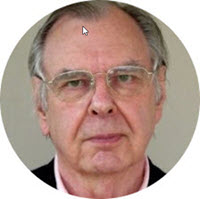
Dave passed away on April 19th, 2022 in South Devon, UK at the age of 89. He will be fondly remembered by all those in broadcasting whose lives he touched. He is survived by his wife Joan, daughter Sara and granddaughter Jessica Rose.
Dave provided the content for this profile shortly before he passed away, it was written by him and this profile was extracted from the document he provided.
I started work for Ampex Electronics Ltd on August 17th, 1959, employee number 10 in the UK. I carried out many menial tasks from painting the factory floor to filling in customs forms. Dr Axon the Managing Director, had headed the team at the BBC developing a tape recorder for pictures, under the acronym ‘VERA’ (Vision Electronic Recording Apparatus). The race to make the first commercially viable recorder had been won by Ampex in 1956 and they had hired Dr Axon in 1958 to head up a new UK subsidiary with responsibility initially for design and manufacturing for Europe.
Early in 1960, Dr Axon told me that the company would be exhibiting at the Audio Fair in London and that he had been asked by the parent company in Redwood City California, to allocate someone as the local liaison for the show and that he was appointing me to be that person. The show was a success and I learned how to run a demonstration and generally make a presentation to the audience of about 20 people at a time. After the show was over, Dr Axon gave me responsibility for the Ampex consumer line of tape recorders and speakers. Thus began my career in sales as well as exhibition organizer.
Later that year, I was asked to go to Paris to help Jim Livingston, the Head of Marketing Services from California, at an exhibition called ‘Mesucura’ where the Company’s data recording equipment was being demonstrated. Our power was quite complicated because we were introducing a product called FR600, a revolutionary data recorder able to record data at a rate of up to 1.2 Megacycles (MHz today) which was far ahead of its competitors, but which also only functioned on 60 Cycle (Hz) power. This had entailed installing a rotary converter on the floor above.
It wasn’t long before once again I was asked to help at an overseas exhibition. This time in Accra Ghana as part of a US Department of Commerce trade show. A German engineer, based in the Ampex office in Bogota Columbia, Klaus Eichstadt, was there to run the technical side of things. It did not start well as the Ghanaian government had insisted everything was shipped into the new port of Tema, close to Accra. The port was ready in terms of docking, but the freight sheds had not been built and consequently our video recorder, a VR1001, was left out in the rain. The Ampex waterproof packing however had withstood the deluge, and nothing was seriously damaged. As a precaution, Klaus borrowed a number of hairdryers from Embassy wives, and we spent two days carefully drying the electronics.
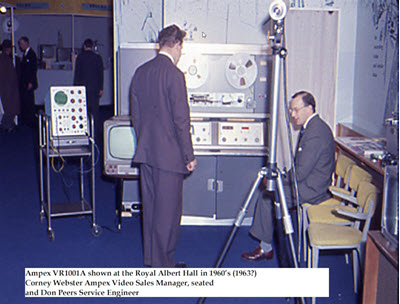
I continued to organize shows and presentations, having learned that the best tool for the job was a roll of five-pound notes in my back pocket.
Later in 1962 I was in Yorkshire running another show, when one of the Computer sales staff arrived and announced that his department had a new Secretary and that she
was very attractive. My enquiry about her marital status was met with an inscrutable ‘wait and see’ response. On my return, I wasted no time in engineering an introduction to Joan, offering to demonstrate some
of the company’s products, especially the consumer Hi Fi range.
Joan and I were married at Reading Registry office on February 22nd, 1964, with my mates Fraser Morrison, an Australian engineer, and Joan's Aunt Vera as witnesses.
Soon afterwards I was made Distributor Sales manager looking after Scandinavia and Africa through representatives and also added professional audio sales to my responsibilities. 1964 was also the year Ampex introduced the production version of the VR2000, the first video recorder designed for colour. It had been a long development process, starting with two specially modified VR1000C (known internally as VR1000D) designed in collaboration with BBC. One of these was sent to BBC Research, the other to BBC Designs department. From this work and after beating off competition from RCA, Ampex were awarded a contract for six VR2000. These first six had no built-in monitoring and were only two equipment racks wide. They were to be delivered to the Television Centre in Shepherds Bush but before that had to be accepted by BBC Planning & Installation department in our lab, this took almost a year.
I also made my first sales tour of Africa as Distributor Sales Manager in 1966. We were entertained royally in South Africa especially by Eric Gallo who arranged a weekend in the Kruger National Park. We were lucky and saw a wide variety of game including over 30 lions. From there we went to Livingston in what is now Zambia and crossed the Zambesi to stay at the Victoria Falls Hotel and spend some time in awe of the falls. From there in a somewhat shaky old Vickers Viscount of Air Rhodesia (until a few weeks before it had been Central African Airways) to Salisbury. We were in Rhodesian TV with John Terry, the MD, as Ian Smith returned from his failed negotiations with Harold Wilson on HMS Tiger. There was much concern that we would not be able to leave, but the BOAC VC-10 showed up on time and off we went to Nairobi. From Nairobi, I went on to Addis Ababa where I met Keith Dunford for the first time, as well as my old friend Fritz Berliner who had run the show in Ghana in 1961.
A small digression: business life in the 60’s was unlike it is today in 21st century. The business lunch was an institution and customers, and salesman alike could look forward to a long lunch with three courses and appropriate wines and after lunch brandy or liqueurs. There were no drink/drive laws and of course many fewer vehicles on the roads. It was a time when the Company happily paid for good wine and good food as a way of enticing customers to buy its products.
At a weekly meeting we were told that Vic Sampson, the Video and Instrumentation Sales Manager was ‘No longer with the Company’ and that I was to replace him in the Video department and act as his replacement in the Instrumentation section pending a new appointment. This was the first inkling I had of this major promotion. I hired Mike Downing from Pye TVT as well as Dave Picket and John Anthony for non-broadcast sales. Mike finally moved on to one of our customers. Recruiting his replacement proved hard and just as I was about to settle for someone, I had a call from the head-hunter that they had a candidate from the BBC that I should see. A meeting was duly arranged after hours in the ‘County Arms’ pub and I met Willy Scullion. He was such a bright and personable Northern Irishman that I had a hard time making myself consider his application overnight, before offering him the job the next day. Willy remains a friend, 40+ years later and went on to achieve great things both in Ampex, Abekas and latterly as Deputy MD of Sony Broadcast where he ran the Broadcast side of the business. I was also able to persuade Harry Armstrong to join us from Marconi CCTV division to look after non-Broadcast business.
My first visit to Redwood City came about in 1967. In late 1966, we had a complaint from Granada Television in Manchester that the head life on the Ampex video recorders was poor and demanding a senior expert to visit and see what was wrong. The company arranged for its famous travelling ambassador, Joe Roizen, to travel from Australia to UK enroute back to California. After resolving the issue Joe suggested they send Keith Fowler, Chief Engineer Operations and Derek Tyldesley, Chief Engineer Planning to the NAB convention to be held in Chicago in March 1967. Granada agreed, but only on condition they were accompanied by the appropriate person from Ampex UK, in this case me.
After NAB with the Granada engineers I visited Redwood City for the first of many times. I have lost count, but I must have attended at least 25 NAB shows, in Chicago, Washington DC, Dallas, Atlanta and numerous times in Las Vegas which became the permanent home for the show. I was also fortunate enough to attend the European equivalent shows in Montreux, Switzerland, missing only the first one when I was in Paris, and every IBC in London, Brighton, and Amsterdam up to the year 2000. The two shows were on alternate years until the late 1990’s when IBC became annual, and Montreux faded away due to lack of space for a growing number of participants. My time took me from the VR1000C to virtually the end of video recording on tape.
By this time, the office had moved from the old house at 72 Berkeley Avenue (Wuthering Heights as it was known in California) to a purpose-built office and factory unit on the other side of Reading. First with my original team and then with Willy’s help, we became very successful and had the highest market share of video recorders anywhere Ampex operated, including the USA. The only stations not using our product were Grampian, a small station in Aberdeen, Scottish Television, and ABC Teddington under the formidable Howard Steele.
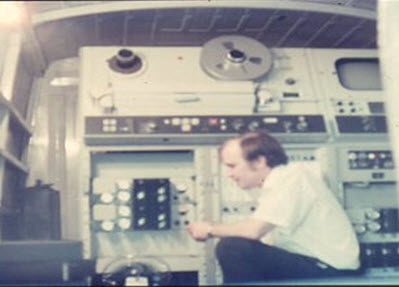
In those early days of Television recording, there was much improvisation, for example in the mid 1960’s, Mrs Topham who owned Aintree and the TV rights to the Grand national horse race, decided that she would not permit a live transmission of the race. The BBC quickly cobbled up an arrangement whereby the live signal was recorded on one VR1000C and the tape then was played back a second or so later on another machine on the other side of the corridor. Rediffusion responded in a similar way to a complaint of an obscenity being used in a live programme, by locking one of the lifts on the ground floor and looping the tape from a machine on the 6th floor down the lift shaft and back up to another similar machine. This provided a delay of several seconds, plenty of time to eliminate any unacceptable words by cutting the signal to the transmitter. I was fortunate indeed to be involved in this pioneering period of the Television industry and even more fortunate to be taken under the wing of Charles (Chuck) Andersen, then the video recorder project manager at head office in Redwood City California. Through him, I met and became a friend of Charlie Ginsburg, a legendary figure who had headed the team that developed the Ampex recorder, VR1000.
I had been worked at Ampex for ten years, when I was told that the Company had been planning an office in South Africa for the following year but would move the opening forward if I would agree to become the first Manager. Management agreed that we could travel out to South Africa by boat, so in September 1969, we embarked on the Edinburgh Castle at Southampton to start our new life. I wanted to get on with life and here we were, on a boat for eleven days. We did however meet some interesting people on the voyage, Abie Krock who owned a chain of supermarkets and a vineyard, Bellingham, and John & Stella Cavill, a Rhodesian and his Irish wife. John was a financial journalist and our paths crossed for some years after we left South Africa.
We docked at last in Cape Town and were met by Ted Baker, Gallo manager in that city. He installed us in the Elizabeth Hotel in the Sea Point area of the city. My white Company Volvo 144 was delivered to the
Hotel the next day and we set out to drive to Johannesburg, about 1000 miles.
The plan was that the office would support the activities of the Ampex distributors, Gallo Africa and Leigh & Hurwitz. I had met Eric Gallo a number of times before we moved to Johannesburg and was happy to
accept his offer of office space for our new venture. Eric was the titular head of the Italian community in South Africa and a delightful man. Although he had a large staff of African workers, they were well
looked after, including in retirement, and worked for him with a smile; stark contrast to most of the Apartheid era South Africa. There was no TV at that time in South Africa and part of my job was to develop
a good relationship with the future key decision makers. This I managed to do with Douggie Mills, the Director of Engineering, Neil Smuts, his head of planning and others.
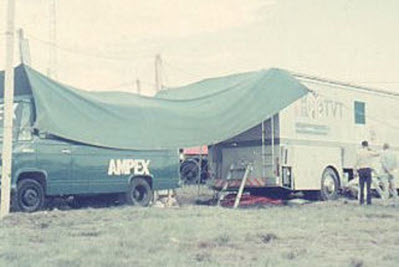
I managed to increase Ampex business and set the stage for TV which came later when we were successful in obtaining the orders for all their video recorders as well as three mobile recording vans. I also became re-acquainted with Keith Dunford whom I had met some years before in Ethiopia. Keith is a bright fun-loving Lancastrian, and we are in touch with him and his wife Ena to this day. It was Keith who, in 1971 organised the first ever TV outside broadcast in South Africa. He managed to persuade Pye Television to divert a four-camera mobile unit destined for Australia via South Africa for the motor racing Grand Prix at the Kyalami circuit. Ampex flew in a VR1200, and Dick McEwen and I made a mobile recording unit by fitting it into a rented Mercedes 608 van. The tapes were rushed to Jan Smuts airport and thence to London.
Our contract was for two years, and we had planned some family tourism in the second year, to Rhodesia and the Victoria Falls. Fate however intervened in the form of a phone call asking if I would consider moving to set up a new Middle East office in a place of my choosing, Beirut or Athens being the most likely locations.
I had made one trip back to UK from Johannesburg, travelling via Nigeria, to investigate a problem with the VR1001 which had installed in Accra as the first video recorder in sub-Saharan Africa, at WNBC in Ibadan. The problem was the machine would not play back older recordings although it wasn’t too bad with recent ones. I found a test tape, found the vacuum guide that held the tape against the rotating heads, to be incorrectly set up, but was surprised when, winding the guide in to remove the error, resulted in the tape popping out of the top of the guide. This baffled my limited knowledge and I promised to take it up on my return. We found they had connected the 3 phase drive the wrong way and that consequently, the head was rotating backwards. Quite a tribute to the design that it played at all!
My second trip back to UK was to talk about the new job, which Joan and I had talked about and accepted. The deal was quickly done, and I set off with Mohamed Reda, who looked after
sales in the Arab world. We went first to Lugano, the unlikely location of the Ampex office then in charge of the Middle East. From there we went to Beirut where I spent a couple of days before going
on to see what Athens had to offer. I returned to Jo’burg, having decided we had to be in Beirut.
Part of my mission had been to find a successor, necessary before I could move, and we appointed John Allen, a data recording sales engineer to run the South Africa office, reporting to me in Beirut.
We opened the office for business without delay, recruiting Dick McEwen, an Australian, as Service manager.
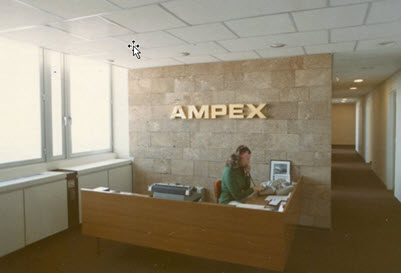
I don’t know what wisdom or accident provoked Ampex to open the Beirut office, but in less than a year, the first ‘Oil price shock’ had hit and suddenly the whole area was swimming in money. Top priority for every government seemed to be an airline and modern airport to go with it, and a TV station. In no time at all, our business doubled and then doubled again until eventually after 5 years, it was 15 times the first year. This was very timely for Ampex who, through unwise investment in the consumer market, were in financial difficulties. The office grew through the addition of Harry Armstrong to look after Africa and Turkey and Iran which we had now taken over.
Beirut meanwhile remained relatively calm, except on the roads where the driving was like Rome on steroids! This all changed in May 1973, when trouble broke out and various Palestinian groups, mainly the Syrian backed factions, came into conflict with the Lebanese army. After 1973, things were never quite the same although for the most part the hectic pace of life continued.
In 1974 we became deeply involved in the TV coverage of the Asian Games, held in Tehran whilst the Shah was still in power. Iran had ‘decided’ to use the French SECAM system for TV transmission. I put decided in parentheses because the TV (NIRT) had in fact decided to use the German PAL system and I had been confidentially told of this by the Ampex training manager, Matt Mc Gillicuddy, when he passed through Beirut having had dinner the previous evening with the NIRT Chief Engineer. Politics however was the final decider because the next day, President Pompidou of France had visited Tehran en route home in Concorde, from a state visit to China. As a result, NIRT received instructions from the Shah that they would use the SECAM system. This did not help, since few people other than France had adopted this system and not all equipment was fully developed to accept it. We had a talented crew of engineers to support the games and outside their job description they carried out changes and modifications to get it all to work. In the end it all went smoothly.
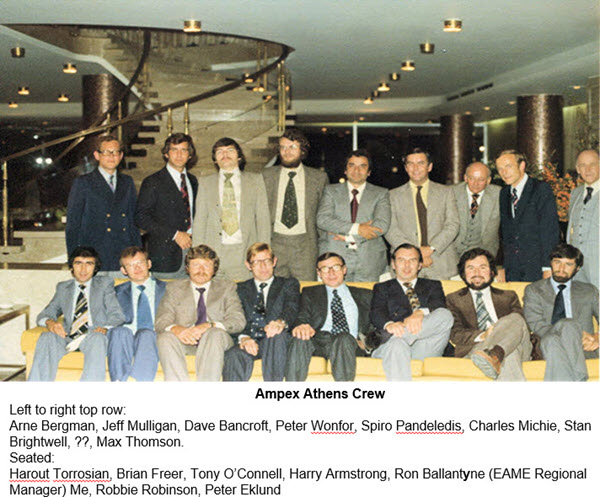
By late-1974, I was becoming increasingly concerned about security in Lebanon. Our Saudi Arabian representative, had told us to expect the worst. I took this knowledge to Reading and in a meeting with Ron
Ballantyne, my boss, I proposed that we make a contingency plan by opening a sub-office in Athens and move Harry Armstrong and his team there, Athens being just as convenient for travel to Africa etc. as Beirut.
Accordingly, on my return from the Asian Games, we set up a small office in two rooms not far from the Acropolis.
By the beginning of 1975, things were getting worse in Beirut, and I met with Ron in Athens and agreed we should initiate phase two of our plan which was to move everyone except Stan Brightwell, Keith Johnson
and Reda and some of Lebanese support staff.
I had recruited Keith Johnson, an ex-BBC engineer and now Sales Manager in the Ampex Stockholm office, to run the Beirut branch. For a short time, all went well but then fighting intensified in Beirut and by
May we had decided to move everyone to Athens. By the end of May, everyone was safely out of Lebanon.
In 1976, Joan and I arranged a trip to California to explore the possibilities there. I was unable to penetrate the Ampex Video Division ‘Mafia’ and returned without any job offer. We opted to return to Reading
and after some time I was able to negotiate a job at the Reading office, running the Systems Group, which had been set up largely to engineer complete fixed & mobile TV systems for the Middle East.
By now I had looked at the books and realized that, on average, the group were 50% over
budget on projects and about 3 months late. Clearly this was a state of affairs that had to stop. I devised some simple paper-based planning charts, and issued an edict that no purchasing would be
permitted without a time plan and a major item purchase plan. Within a year we were performing to within 5% of budget and more or less on time. Another innovation was in the area of proposals, Hereto; a
specific proposal was generated for each opportunity without any assessment of the chances of Ampex being the successful bidder. We instituted a qualification process to decide how and even if we would respond.
The result was that of the highest category, where we thought we had a reasonable chance of an order, we started to convert over 30% of proposals into orders. Since this was the only category where we put real
time into a specific proposal, our proposal costs finally came under control.
Gradually, the rest of Ampex International Companies began to recognise that providing a complete working TV system could increase their sales and we built systems for Bolivia, Korea, Taiwan, and other markets
outside our original geographical remit. It however proved impossible to convince the people in Redwood City. This wider market gave me new travel opportunities and I visited several far Eastern countries
including Hong Kong where landing at the old Kai Tak airport was interesting to say the least.
One of our achievements was to be able to help sell Ampex’s new colour camera, something that proved almost impossible as a standalone product. Ampex was not known for cameras and the conservative buyers
seldom ventured beyond the traditional suppliers like Marconi, Pye and EMI in UK, Fernseh and Philips in Europe and RCA and GE in America. In our second year, we made 24 mobile systems of one sort or another,
including our first major UK contract for Yorkshire Television, to be used for their Emmerdale Farm programme. In addition, we did a complete studio installation for RTL (Luxemburg) for a new production
facility, the first Ampex studio camera installation in Europe.
I attended the NAB Conventions in America as part of my job, in 1979 I was standing on the Ampex stand when Howard Steele, whom I knew as Director of Engineering at the IBA, the controlling body for commercial TV, including technical standards, appeared, accompanied by a number of Japanese. Howard, probably the brightest and most acute engineer in Europe, had, to everyone’s surprise, recently joined Sony Corporation of Japan. He saw me, came over and introduced me to ‘Mori’ Morizono, the powerful head of Sony Non-consumer TV business. Two months later at the European Convention in Montreux, Switzerland, Stuart Sansom, formerly Director of Engineering at Thames TV, who had joined Sony Broadcast as Marketing Director, approached me, and said Howard was interested to talk to me. A few weeks later we met and soon afterwards had a call saying they would like me to join Sony as General Manager, Sales. Nobu Watanabe, a Japanese board member, asked to meet me and offered me a very satisfactory contract to join Sony Broadcast. Joan and I had already discussed the move, so I said ‘yes’ immediately and the next day handed in my notice to Dick Sirinsky, by then the Area Manager for Europe. I started work at Sony two weeks later.
Epilogue
Dave continued his 52-year career in the broadcasting industry at:
- Sony Broadcast
Sales Director – 1979 to 1986 - Snell & Wilcox
Director – 1991 to 1997 - Celtic Audio
Managing Director – 2011 to